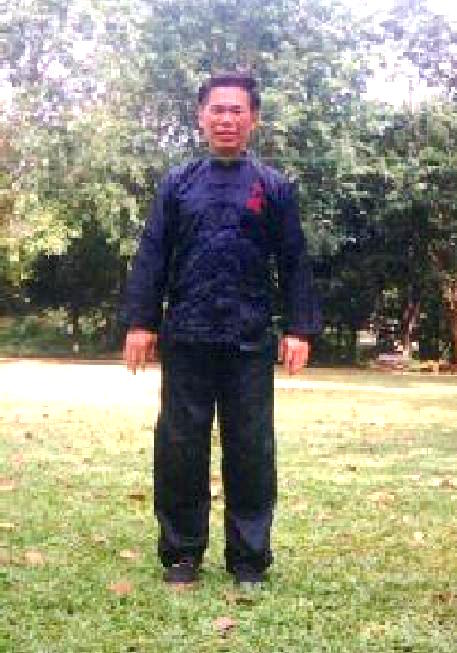THE WUJI STANCE AND THE HORSE-RIDING STANCE

Wuji Stance
Question
In Taijiquan there is a saying of "Taiji originates from Wuji, and returns to Wuji". We always start and finish our practice with the Wuji Stance in order to emphasize this teaching. Why do we use this Stance and not another?
May you please share with us some of its history, origins and philosophy? Why is it called Wuji Stance?
When you taught One Finger Shooting Zen (OFSZ) in Ireland it surprised me that you started teaching us OFSZ first using the Wuji Stance instead of the Horse Stance. May you please share with us the reasons? What are the differences of practicing OFSZ in Wuji Stance in comparison with Horse Stance?
Santi
Answer
The saying that “Taiji originates from Wuji, and returns to Wuji” sums up the philosophy of Taijiquan. “Taiji” means the Cosmos, and “Wuji” means the Great Void.
The Cosmos originates from the Great Void, or the phenomenal originates from the undifferentiated spread of energy. At first there is the Great Void, or the undifferentiated spread of energy. Energy that is quiescent is symbolized as “yin”, and energy that is dynamic is symbolized as “yang”. The interaction of yin and yang gives rise to the phenomenal world. The purpose of Taijiquan is to return to Great Void. In Western terms, it is expressed as returning to God the Holy Spirit.
We always start and finish our Taijiquan practice with the Wuji Stance. This was actually how Taijiquan began. At the time of Zhang San Feng, it was not called Taijiquan. The term “Taijiquan”, which means “Cosmos Kungfu”, was invented by the founder of Chen Style Taijiquan, Chen Wang Ting, in the 17th century, which was 4 centuries after the time of Zhang San Feng.
After his practice of Shaolin Kungfu, Zhang San Feng stood still, relaxed and upright. Extreme stillness generated movement. Soon Zhang San Feng swayed in his chi flow, which resulted in numerous Taijquan patterns. This was expressed as Taijiquan originated from Wuji.
We use this stance, the Wuji Stance, and not another stance because it is the easiest to return to the Great Void. If we use another stance, like the Horse-Riding Stance, the Three-Circle Stance, the Bow-Arrow Stance, the Four-Six Stance, the Single-Leg Stance or any other stance, we would be in the phenomenal realm. Hence it is called the Wuji Stance.
I do not know the exact history, origins and philosophy of the Wuji Stance. What is said below is based on my understanding and experience.
Long before martial arts were institutionalized at the Shaolin Monastery, after engaging in battles warriors like in the Warring States or the Three-Kingdom Period, which were many centuries before the Shaolin Monastery, stood to rest. They discovered over many centuries that if they were not upright, they would block their energy flow. If they were not relaxed, they would also block their energy flow. If they were upright and relaxed, not only their energy would flow smoothly, but also they might enter into a deep state of meditation and return to the Great Void.
Hence, standing upright and be totally relaxed became an important stance. It was much, much later, probably during the times of Xingyiquan, Taijiquan and Baguazhang, that the term “Wuji” was used for this stance.
“Wuji” means “no-ultimate”, or the Great Void where everything is just energy and is undifferentiated. It is called the Wuji Stance because it is the stance that is the easiest to return to the Great Void.
When I taught One-Finger Shooting Zen in Ireland and elsewhere, I used the Wuji Stance because many people would be tired in the Horse-Riding Stance, which would be eventually used.
In other words, One-Finger Shooting Zen should be performed in the Horse-Riding Stance. But not many people can perform the Horse-Riding Stance well. If they perform One-Finger Shooting Zen in a Horse-Riding Stance, they would try to maintain their Horse-Riding Stance and therefore not pay much attention to the movements of One-Finger Shooting Zen.
To help these students, I asked them to stand upright and be relaxed in the Wuji Stance so that they could focus on the movements of One-Finger Shooting Zen. When their movements were correct, they could progress to a Horse-Riding Stance.
Later I discovered that the Wuji Stance was more conducive for energy flow. Energy flow was needed before students could consolidate the flowing energy into internal force. The Horse-Riding Stance was more conducive for consolidating energy into internal force.
Hence there are two main differences in performing One-Finger Shooting Zen in the Wuji Stance and the Horse-Riding Stance.
Performing One-Finger Shooting Zen in the Wuji Stance is easier so that students can focus on the hand movement. It is better for energy flow.
Performing One-Finger Shooting Zen in the Horse-Riding Stance is more demanding, but when students know the movements they can progress to the Horse-Riding Stance because they will be in a better position to consolidate their flowing energy into internal force.

Horse-Riding Stance
The questions and answers are reproduced from the thread Questions on Wuji Stance or Standing Meditation in the Shaolin Wahnam Discussion Forum.
LINKS
